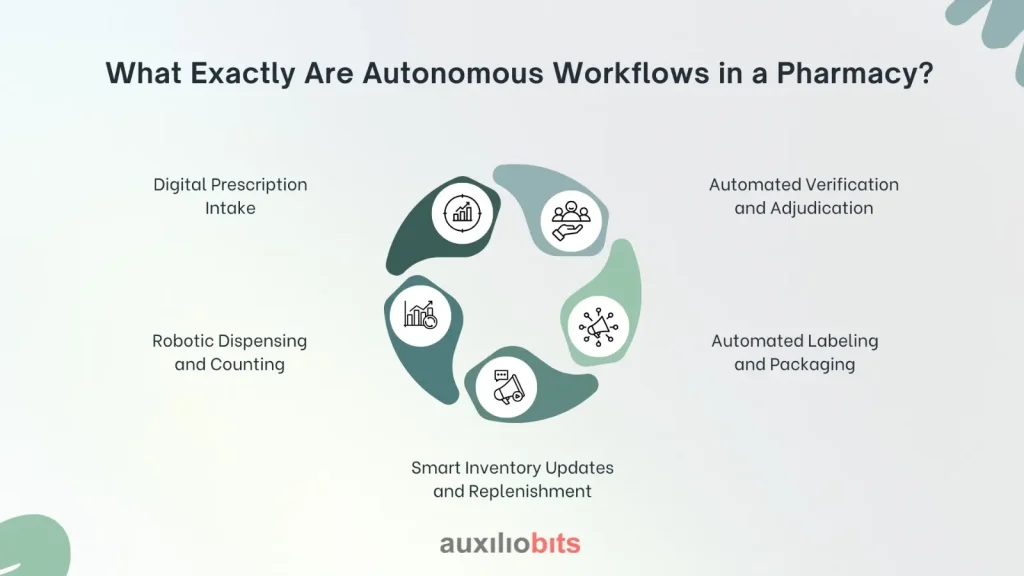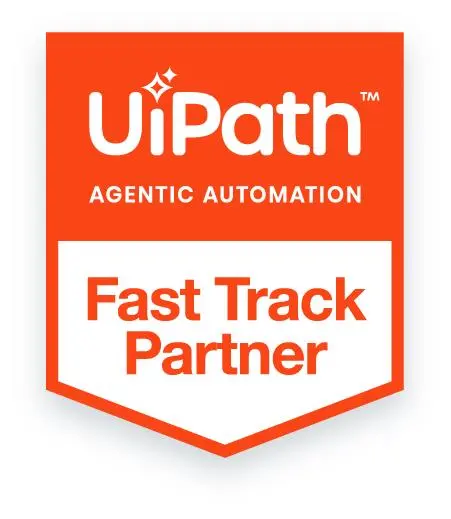
Key Takeaways
- Autonomous systems enhance accuracy in dispensing, labeling, and verification, ensuring that patients receive the correct medications every time.
- Faster prescription processing through automation results in quicker service and increased patient loyalty.
- With repetitive tasks automated, pharmacists gain more time for consultations, chronic care support, and community engagement.
- Real-time inventory tracking reduces waste, prevents stockouts, and helps maintain operational efficiency and cost control.
- A thoughtful, scalable automation plan ensures smooth integration, staff adoption, and long-term adaptability to evolving healthcare needs.
Also read: Agentic AI in Healthcare: Beyond Chatbots to Clinical Decision Support.
Why Automation is a Game-Changer for Pharmacies?
Think about how a pharmacy works on any given day. There’s a constant flow of tasks: counting pills, sorting different medications, meticulously labeling bottles, and cross-checking prescriptions against patient records. When these critical tasks are performed entirely by hand, even the most dedicated and careful person can face challenges such as fatigue, distraction, or the sheer volume of work, which can lead to potential human error. That’s precisely why pharmacies worldwide are increasingly turning to advanced automation.
Here’s a deeper look into how intelligent systems are making a truly transformative difference:
The precision of automated systems is genuinely remarkable. They can count pills with near-perfect accuracy, print unambiguous labels, and perform computerized checks of prescriptions against a patient’s medical history for potential drug interactions or allergies. This significantly reduces the likelihood of critical errors, such as dispensing the wrong medication, incorrect dosage, or a drug that may cause an adverse reaction. For patients, this translates directly into enhanced safety and invaluable peace of mind, knowing their medication is handled with the utmost care and attention.
In an age where convenience is king, nobody enjoys waiting, especially when they’re not feeling well or are in a hurry. Automated systems can process and prepare prescriptions significantly faster than manual methods. This efficiency leads to drastically shorter wait times at the pharmacy counter, creating a much smoother and more pleasant experience for customers. The result? More satisfied and loyal patients who appreciate the speed and professionalism.
One of the most profound benefits of automation is its redefinition of the pharmacist’s role. When machines competently handle the repetitive, administrative, and physically demanding tasks of dispensing, pharmacists are liberated to focus their invaluable expertise where it truly counts. This means more time for meaningful patient consultations, answering complex medication questions, providing vital health advice, offering immunizations, and managing chronic conditions. This shift empowers pharmacists to act as true healthcare providers, strengthening their connection with the community and leading to superior patient outcomes.
Managing a vast inventory of medications can be a complex logistical challenge. Automated systems excel at this. They maintain a real-time, accurate count of every item on the shelves, tracking expiration dates and consumption rates. This sophisticated inventory management enables pharmacies to precisely track what’s in stock, identify slow-moving items, and automatically trigger reorders for popular or essential drugs before they run out. This not only ensures that medications are always available when needed but also significantly reduces waste from expired medications, leading to cost savings and more sustainable operations.
By streamlining processes, minimizing errors, and optimizing inventory, automation delivers substantial long-term savings in both time and operational costs. The initial investment in automation technology is often quickly recouped through increased efficiency, reduced labor costs for routine tasks, and fewer instances of costly errors. These savings allow pharmacies to operate more profitably and invest more in advanced patient services or staff development.
What Exactly Are Autonomous Workflows in a Pharmacy?
Imagine a scenario where a prescription arrives digitally, perhaps from a doctor’s electronic health record system. From that very moment, many subsequent steps begin to unfold automatically, with minimal human intervention. This seamless, self-governing progression of tasks is the essence of an autonomous workflow. It’s crucial to understand that this isn’t about entirely replacing the human element but rather about equipping pharmacy staff with intelligent tools that can independently execute every high-volume task with speed and precision.
An autonomous workflow in a pharmacy typically involves several integrated steps:

Prescriptions are received electronically directly from healthcare providers. This eliminates the need for manual data entry from paper scripts, drastically reducing transcription errors and speeding up the initial processing.
The system instantly verifies prescription details, checks for patient allergies and potential drug-drug interactions, and ensures correct dosages against comprehensive databases. It can also automatically handle insurance adjudication, confirming coverage, and calculating co-pays.
At the heart of many autonomous systems are robotic dispensing machines. These sophisticated machines can accurately count and dispense medications, whether it’s pills into bottles, liquids into containers, or preparing pre-packaged doses, all with incredible precision.
Once dispensed, the system automatically prints clear, accurate, and compliant labels with all necessary information (patient name, medication, dosage instructions, and warnings). It can also manage the secure packaging of medications, ready for patient pickup or delivery.
Every time a medication is dispensed, the pharmacy’s inventory system is updated in real-time. This dynamic tracking ensures accurate stock levels and can automatically trigger reorder alerts or even direct orders to suppliers when a stock falls below a predefined threshold, preventing shortages.
These intricate steps, once manual and time-consuming, now flow seamlessly through interconnected systems, allowing pharmacy staff to oversee the process, handle exceptions, and dedicate their invaluable human expertise to complex cases and direct patient care.
Building a Smart Automation Strategy for Your Pharmacy
For any pharmacy contemplating or implementing this technological leap, having a clear and well-defined automation strategy is not only beneficial but also essential for success. It’s much more than simply purchasing a piece of equipment; it’s about meticulously planning how cutting-edge technology will integrate into the daily operational fabric of the pharmacy and, most importantly, how it will elevate the overall service quality.
Here are the key components that go into crafting an effective automation strategy:
The first crucial step is to deeply understand your pharmacy’s current pain points and biggest challenges. Are long patient wait times a significant issue? Is managing a complex inventory a constant struggle? Is there a desire to free up pharmacists for more clinical services? Identifying these specific needs will guide the selection of the most appropriate and impactful automation tools.
The landscape of pharmacy automation is diverse, offering a wide array of solutions. This includes large-scale robotic dispensing machines, sophisticated inventory management software, automated compounding devices, and advanced prescription verification systems. The optimal choice will depend heavily on the pharmacy’s specific size, the range of services it offers, its patient volume, and its long-term strategic goals. A careful evaluation of various options is paramount.
New automation systems rarely operate in isolation. They need to communicate and work harmoniously with existing pharmacy software, such as patient management systems, electronic health records, and billing platforms. A robust automation strategy includes detailed planning for smooth and efficient integration, ensuring all systems “talk” to each other without glitches, and maintaining data integrity and workflow continuity.
Technology is only as good as the people who use it. It’s vital to invest in thorough and ongoing training for all pharmacy staff on how to operate, manage, and troubleshoot the new automated systems. This empowers them to feel confident and competent with the latest technology, fostering a sense of ownership and ensuring a smooth transition. Practical training also helps staff understand how their roles evolve to focus on more complex, patient-facing tasks.
The healthcare and technology landscapes are constantly evolving. A forward-thinking automation strategy isn’t static; it considers how the implemented solutions can scale with the pharmacy’s growth and adapt to future advancements in medication management, regulatory changes, and emerging healthcare needs. It’s about building a foundation that can evolve rather than becoming quickly obsolete.
The Bright Future of Prescription Handling
The widespread adoption of pharmacy automation and the development of increasingly sophisticated autonomous workflows represent more than just technological trends; they mark the next logical evolution in healthcare delivery. This movement is fundamentally transforming how prescriptions are handled, making the entire process more efficient, incredibly accurate, and profoundly patient-centric.
By thoughtfully and strategically integrating these intelligent systems, pharmacies can ensure that receiving vital medications is a consistently smooth, remarkably safe, and undeniably positive experience for every patient. This progressive approach allows pharmacists to truly maximize their professional impact, dedicating their invaluable clinical expertise to direct patient care and consultation. At the same time, intelligent automation precisely and tirelessly manages the critical behind-the-scenes work.








